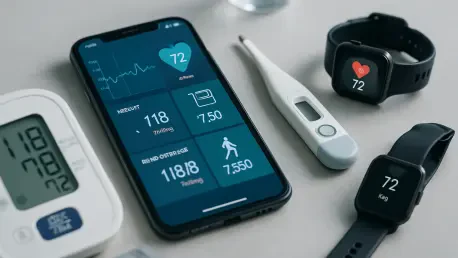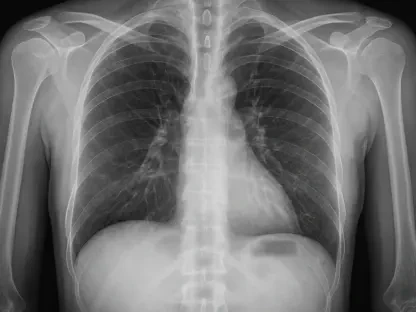In an era where technology is reshaping every facet of life, digital health stands out as a powerful force poised to redefine the medical technology (medtech) industry and transform healthcare delivery. Innovations such as interoperable electronic medical records (EMRs), blockchain for secure data frameworks, remote patient monitoring (RPM), and additive manufacturing through 3D printing are converging to create a system that prioritizes personalization, efficiency, and patient-centered care. These advancements promise not only to enhance patient outcomes but also to streamline operational processes and curb escalating costs. However, with great potential come significant challenges, including data privacy concerns, regulatory complexities, and the pressing need for equitable access. This exploration delves into how digital health is paving the way for a new era in medtech, examining the synergies between these technologies and the obstacles that must be addressed to fully realize their impact on the future of healthcare.
Revolutionizing Data with Connected Systems
The backbone of digital health lies in interoperable EMR systems, which enable a seamless flow of patient information across diverse healthcare providers. This connectivity ensures that clinicians have access to comprehensive, up-to-date data, fostering better coordination and informed decision-making. When a patient’s medical history, test results, and treatment plans are readily available, the risk of errors diminishes, and care continuity improves significantly. Despite these advantages, the reality is far from perfect. Fragmented records and incompatible software often disrupt workflows, leading to inefficiencies and gaps in care. Overcoming these barriers requires not just technological upgrades but also a commitment to standardization across platforms, ensuring that data sharing becomes a universal strength rather than a persistent weakness in modern healthcare delivery.
Blockchain technology emerges as a compelling solution to bolster the integrity and security of healthcare data within EMR systems. By providing an immutable record of data access and transactions, blockchain enhances trust and transparency, particularly in tracking medical devices and supporting clinical trials. Early pilot projects, especially those using private or permissioned blockchain networks, have demonstrated success in maintaining data traceability for implantable devices. Yet, scaling these initiatives to a broader level remains a complex endeavor. Regulatory uncertainties and the need for robust infrastructure pose significant hurdles that the industry must navigate. As digital health continues to evolve, finding ways to integrate blockchain effectively while addressing these challenges will be crucial to creating a truly connected and secure healthcare ecosystem that benefits all stakeholders.
Expanding Reach with Remote Monitoring
Remote patient monitoring (RPM) represents a groundbreaking shift in how care is delivered, extending medical oversight beyond the walls of hospitals and clinics. Through wearable devices and home-based sensors, RPM captures real-time data on vital signs such as blood pressure, glucose levels, and heart rhythms, integrating this information directly into EMRs. This capability allows healthcare providers to intervene proactively, often preventing complications before they escalate. For patients with chronic conditions, this means fewer emergency visits and a greater sense of control over their health. The technology not only reduces the burden on healthcare facilities by cutting readmission rates but also aligns with the growing demand for patient-centered care that prioritizes convenience and accessibility in everyday life.
While RPM holds immense promise, its success hinges on addressing critical issues surrounding data quality and patient privacy. The influx of continuous data must be both accurate and actionable to avoid overwhelming clinicians with irrelevant or erroneous information. Secure architectures and standardized application programming interfaces (APIs) are essential to filter and prioritize incoming data effectively. Equally important is safeguarding sensitive patient information against breaches, as trust remains a cornerstone of digital health adoption. As the medtech industry pushes forward with RPM, striking a balance between technological innovation and robust privacy measures will determine whether this tool can truly transform care delivery on a global scale, ensuring that benefits reach patients without compromising their security.
Customizing Care with Advanced Manufacturing
Additive manufacturing, commonly known as 3D printing, introduces a remarkable dimension to digital health by enabling highly personalized medical solutions. Drawing from detailed patient data in digital records and imaging studies, this technology produces custom prosthetics, surgical guides, and anatomical models tailored to individual needs. Such precision enhances surgical planning, improves outcomes, and often reduces recovery times for patients. Beyond clinical applications, 3D printing offers cost-effective alternatives to traditional manufacturing, making specialized devices more accessible. As this technology integrates with broader digital health systems, its potential to revolutionize patient care by delivering bespoke solutions directly at the point of need becomes increasingly evident.
However, the rise of 3D printing in healthcare also brings unique challenges, particularly around regulation and safety. Decentralized manufacturing at the point of care raises questions about quality control and compliance with medical standards. Linking production workflows to verified supply-chain data, potentially through blockchain, can help ensure material authenticity and device reliability. Regulatory bodies are gradually adapting to these innovations, but the pace of change often lags behind technological advancements. For 3D printing to fully integrate into the medtech landscape, clear guidelines and oversight mechanisms must be established. This will not only protect patient safety but also encourage wider adoption of a technology that holds the power to personalize healthcare like never before.
Securing Trust and Ensuring Equity
As digital health technologies gain momentum, the emphasis on data security and privacy has never been more critical. The vast amounts of sensitive information flowing through EMRs, RPM systems, and other digital tools necessitate robust safeguards to prevent breaches and maintain public trust. Solutions like blockchain and secure APIs are gaining traction as means to protect data integrity and ensure transparency in transactions. This focus reflects a broader industry consensus that without trust, the adoption of digital health tools will falter. Building secure frameworks is not just a technical requirement but a fundamental step toward creating a healthcare system where patients and providers alike feel confident in the safety of their interactions and information.
Equally pressing is the challenge of ensuring equitable access to digital health innovations, alongside navigating regulatory landscapes that often struggle to keep up with rapid advancements. Disparities in infrastructure and resources threaten to widen existing healthcare gaps, leaving underserved populations without the benefits of these technologies. Meanwhile, regulatory frameworks must evolve to balance innovation with accountability, ensuring that safety standards are met without stifling progress. Addressing these barriers requires collaboration across the medtech industry, policymakers, and community stakeholders. Only through such collective efforts can digital health fulfill its promise of transforming healthcare into a more inclusive, efficient, and patient-focused system that serves everyone equitably.
Reflecting on Progress and Looking Ahead
Looking back, the journey of digital health within the medtech sector reveals a landscape of remarkable innovation tempered by significant challenges. Technologies like interoperable EMRs, blockchain, RPM, and 3D printing have demonstrated their capacity to enhance patient outcomes and streamline care delivery. Yet, hurdles such as data privacy risks, regulatory inconsistencies, and access disparities underscore the complexity of this transformation. Each advancement brings with it a clearer understanding of what is needed to build a resilient healthcare ecosystem. The strides made highlight a collective determination to prioritize patient-centered solutions while grappling with the intricacies of implementation.
Moving forward, the focus must shift to actionable strategies that address these lingering obstacles. Strengthening cybersecurity through advanced encryption and standardized protocols will be vital to protect sensitive data. Simultaneously, investment in infrastructure and education can help bridge access gaps, ensuring that digital health benefits reach all corners of society. Regulatory bodies should work closely with industry leaders to craft adaptive policies that encourage innovation without compromising safety. By fostering collaboration and maintaining a commitment to equity, the medtech field can harness the full potential of digital health to create a future where healthcare is not just advanced, but also universally accessible and deeply personalized.









